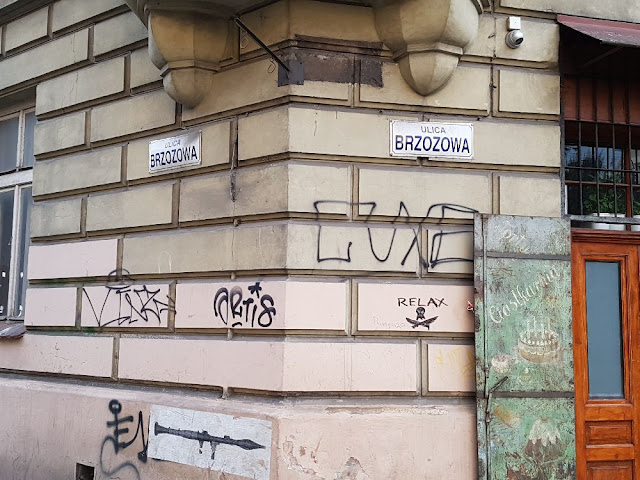Krakow
Also a UNESCO city (in fact one of the first so designated) Krakow is a beautiful jewel of historic architecture and a sad story of history. The city was not damaged much in WW2 and the buildings you see there are pretty much original.
 |
| Krakow Castle |
The Nazis took over Krakow in 1939 and set to work to make it a German city. A section of the city was walled off for the Jewish Ghetto (at that time some 200,000 Jews lived in the Krakow district, by the end they had all been deported to either concentration camps or labour camps, or killed outright).
 |
| On our walking tour of the Jewish area in Krakow |
Krakow was also the site of the enamelware factory made famous by the movie Schindlers List. This factory is now a museum.
 |
| Display in the museum currently housed in the Schindler Factory |
 |
| Products typical of Schindler Factory |
Beyond the WW2 historical settings there is a castle and a hall for commercial trade (Cloth Hall, now a spot for tourist shopping) plus beautiful horse and carriages set up to take one around the town.
 |
| Cloth Hall - great spot for souvenirs |
 |
| Very pretty horses and carriages |
In this city (our first stop in Poland) we found our first pierogie restaurant. It was just down the street from our hotel, and near our favourite corner
 |
| Yup - the corner of Brzozowa and Brzozowa |
Ok – The restaurant did not sell just pierogies but that is what we had, and they were so good that we went back for three visits in total. The pierogies here are different from the ones I eat in Canada. The filling is lighter and the dough significantly thinner so the entire meal is not so heavy. We tried pierogies other places but none were quite so good. Overall our pierogy trials included potato/cheese (Ruskie), meat, black lentils, blueberries and plum.
 |
| Ruskie |
 |
| Plum |
 |
| Blueberry |
On a food vein in Krakow we did our second evening with Eatwith.
This is an arrangement where you pay to eat hosted by a local of some sort. We did two of these evenings, one in Budapest and one in Krakow. In Budapest the woman who ran it was a caterer with a professional kitchen arrangement and she served typical Hungarian food from her grandmother's recipes. In Krakow we ate at a local woman’s apartment and she does dinners like this once a week to really show off the local food. She described it as a very serious hobby, though food seemed a bit entrepreneurial for her too. In her other life she is a sculptress, married to an artist, so the apartment itself was quite neat. There were the four of us, plus two gentlemen from LA and one lady from Korea. Dinner included us trying 5 courses of local dishes and an awful lot of trials of local adult beverages (namely vodkas, such as honey vodka and lemon vodka). Great fun.
 |
| Marta, our Eatwith Host |
Wieliczka Salt Mine
A fun, different sort of thing to see near Krakow is the
Wieliczka Salt mine. This is a real salt
mine that was opened in the 13th century. All but the very last of it was dug by hand
and the mine itself goes 327m deep and 287 km long. What you get to see as a tourist is only 2%
of that, about 3 km and we only went 135m deep. That said, the first thing one does is go
down something like 378 steps (luckily there is an elevator up, else I dare say
the tourist dollars generated would be much much less).
 |
| Down, Down over 50 flights of stairs |
This is a very cool place with tunnels going from chamber to
chamber. Salt in a mine was described as
being like raisins stirred into a cake…. There is a lump of salt that gets dug
out to form a chamber and then there is a tunnel to the next lump. Along these tunnels I did the obvious – lick my
finger and touch the wall. Indeed, it was salt!
There are many statues made of salt throughout the mine and several
chapels as well.
 |
| Statues of Salt depicting Legend |
The largest rooms that
we were able to view were set up for use in private functions such as weddings
(I hear the bride is allowed to go down in the elevator). Many of the carvings and statues have a religious
theme, including one of Pope John Paul II who was Arch Bishop in Krakow before
his rise to Pope.
 |
| Large room with chapel on one end and many religious salt carvings on the walls |
 |
| Chandelier made of Salt Crystals |
 |
| Function Room |
The mine produced commercially until 1996, when I understand
it became not financially viable. You
can buy souvenirs in a shop inside the mine, including salt labelled Wieliczka,
but no idea where it actually comes from if the mine itself is no long
producing…..
 |
| Shop Area, showing support structure of salt impregnated wood |




















Comments
Post a Comment